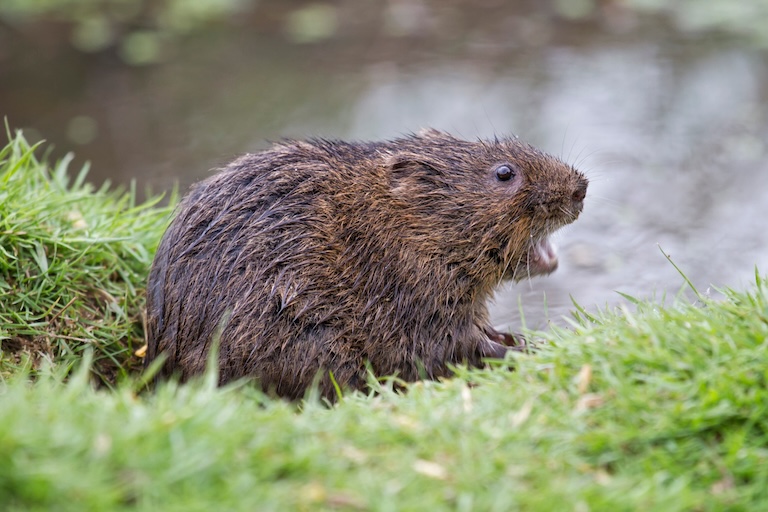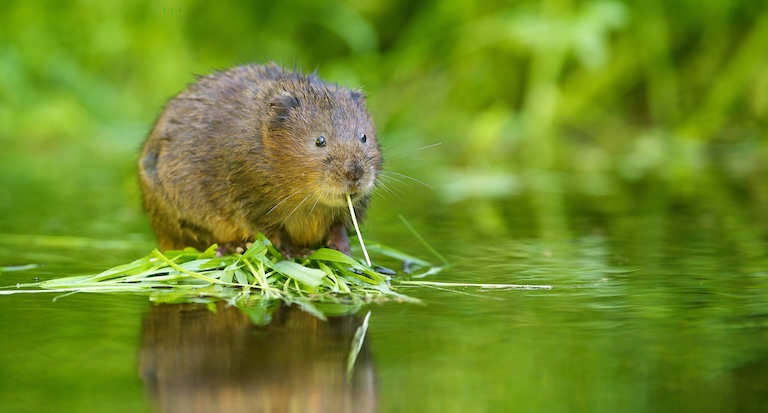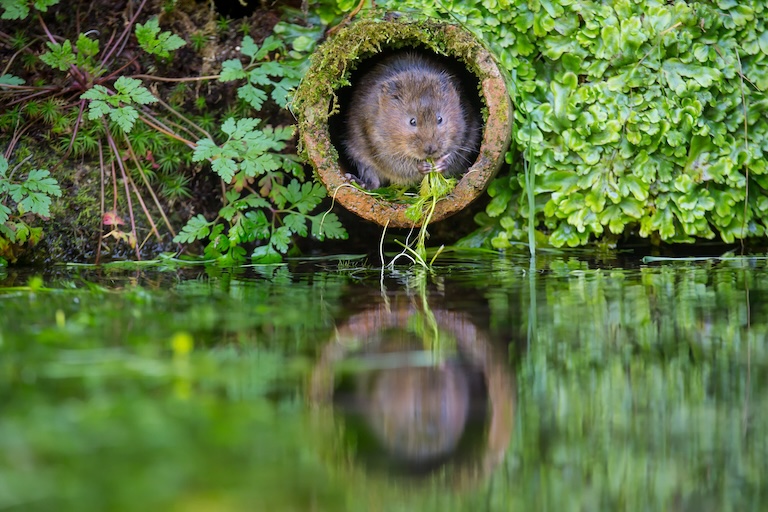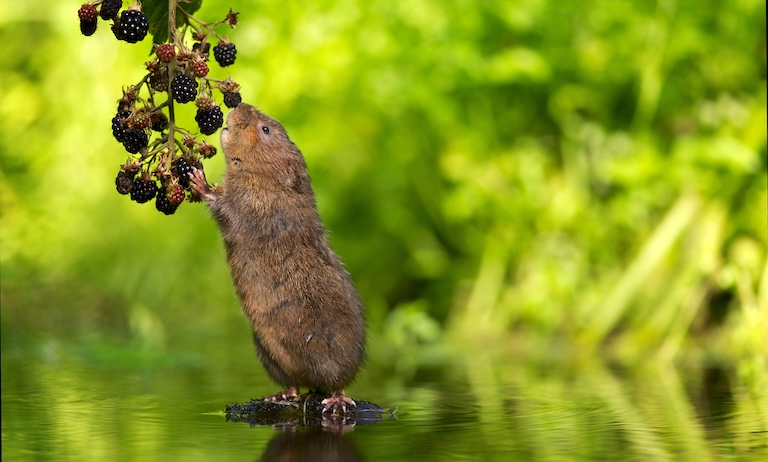Water Vole Profile
The order Rodentia is the most diverse order of mammals on Earth, yet the majority of them are too often grouped under the “Eww, gross” category by many people.
Rats have an undeserved reputation for spreading plague, (they didn’t – it was the fleas on humans), and this rather bigoted basis for persecution appears to have been extended to anything small and fluffy and rodent-like ever since.
But while there may be some valid concerns about the role of Murids as disease vectors in some contexts, voles most certainly don’t deserve the animosity.
They’re cute, smart, and ecologically important, and semi-aquatic species like the water voles help keep our rivers healthy.

Water Vole Facts Overview
| Habitat: | River banks, wetlands |
| Location: | Eurasia |
| Lifespan: | 6-18 months in the wild! Up to 30 months in captivity. |
| Size: | Around 22 cm (8.6 in) long, |
| Weight: | 150g to 300 g (5 oz to 11 oz) |
| Colour: | Dark grey-brown |
| Diet: | Grass, fruits, bulbs, twigs, buds, and roots, sometimes small animals |
| Predators: | American mink, cats, native mustelids, raptors, snakes |
| Top Speed: | Fast swimmers |
| No. of Species: | 3 |
| Conservation Status: | The southern water vole is Vulnerable, other species Least Concern (IUCN). |
Water voles, despite being found all over Eurasia, are more commonly related to the New World rodents.
They’re round-faced, semi-aquatic, and very adaptable in their diets – something that researchers have reluctantly had to come to accept.
As rodents, they breed fast, and their numbers can be a bit overwhelming for farmers in some places, but they are a significant contributor to a healthy ecosystem as both predator and prey.
Sadly, as we shore up our riverbanks more and more, we are removing the necessary habitat for these impressive little mammals, and they’re on the decline.
Interesting Water Vole Facts
1. They’re Old World rodents
Rats and mice, at least, the original rats and mice, are members of the Muridae family and originate from Asia. When Europeans moved to the Americas they were met with very similar-looking rodents which they called rats and mice but weren’t, quite.
These “New World rats and mice” are members of a separate family, the Cercetidae, and one of the few groups of rodents that made it into the Americas.
But they’re not alone in this family – there are Old World rodents in it too, including the hamsters, who come from Europe and North Africa, and the Voles.
Water voles are therefore more related to the American “rats” than they are to the brown rat they share a continent with.
They’re a large and adaptable species, capable of living underground and in the water, but don’t strictly need water at all, other than enough to drink. In Eurasia, there are three main species. 1

2. There are three species
The European water vole is the widest-ranging of the three, found in most of Europe, Russia, West Asia and Kazakhstan. This is the largest species of vole found in Britain and is endangered there due to habitat destruction and invasive mink species.
The Southwestern water vole, which was until recently thought to be the same species as the European water vole, is threatened by many of the same problems and is found through much of Spain, Portugal and France. This species was once a staple in the traditional dish Paella.
Then, there’s the Montane water vole, which is also found throughout mainland Europe but in a smaller range from Northern Spain and Portugal Eastward into Romania.
Again, this was thought to be the same species as the European water vole until around the year 2000, showing how similar the three are in appearance and behaviour.
But some of these behaviours are a little hard to swallow. 2
3. They’re Vegan-ish
Science is all about packaging the ultimately chaotic and inexplicable universe into neat little boxes that can help us come to terms with the maelstrom of subjective experience. So, when experiments show that something exhibits a wave-particle duality, it gives all but the most nihilistic scientists a headache.
But that’s physics, and physics is hard to explain. Animal behaviour is a lot easier on the mind – though you wouldn’t realise it by reading the headlines.
The water vole has its own version of the double-slit conundrum: widely known as a herbivore, the water vole confounded researchers when it was observed sneakily chowing down on frogs. People took to the streets as their understanding of the universe collapsed like a wave function in a busy theatre.
But this shouldn’t be a surprise to anyone. Herbivores often have a low-protein diet, and while their hardware (teeth, eyes, gut, etc.) is designed with this in mind, it doesn’t hurt to have at a steak or two if they can get one, just as an easy injection of protein to balance all the greenery.
This is what happens with water voles. In at least one location, they’ve been seen nibbling on frogs’ legs and discarding the body.
This behaviour was apparently described by experts as, “Incredibly unusual”, but that was back in the naïve and whimsical era of the 2010s.
Since then, we’ve seen similar behaviour in hippos, deer, cows, and various other so-called herbivores, and the understanding has shifted away from absolutes and into the less comfortable grey areas.

4. They breed like rodents
Water voles get it on. They can produce up to four litters each year, and there can be five pups in a litter.
It doesn’t take Wolfram Alpha to infer from this that a single female water vole can create 20 more such animals in a single year, should she have access to the willing male counterpart, and she can get started as soon as she’s sexually mature, at just a few weeks old.
For a human with an average life expectancy of 70 years, this would amount to roughly 1400 offspring, but nature has a way of balancing things out, and in the case of the water vole, it does so with a very limited time frame. 3
5. They die!
In the wild, the lifespan of a water vole is somewhere around five months. They have been known to make it to 18 months, after which they get a telegram from the queen, but it’s a rare occurrence, and even in captivity, where they do significantly better, their upper bound is around 5 years.
This does explain why they’re in such a hurry to make babies and aren’t so fussy about their diets.
6. They swarm
When they’re not baffling journos, they’re mostly eating grass. Water voles leave a characteristic 45-degree cut on vegetation stems, and get most of their diet from riverine grass species but they’re also very happy to find fruit, nuts, roots, and flowers to mix things up a bit.
When the food supply is rich, so is the vole supply, and in perfect conditions, “plagues” have been reported. This is basically water vole Woodstock, and they will all come out of their burrows, eat everything they can and dig holes in the ground.

7. They’re ecosystem engineers
Far from being a mere pest, this species and its powerful potential play an important role in the ecosystem. All that munching controls the growth of vegetation on the river banks and helps to dictate the quality of the river itself.
All those little pups being born provide a huge amount of food for predators like owls and other raptors, snakes, foxes, and various important native hunters.
And of course, all the consequent pooping recycles nutrients into the soil and the river itself. 4
8. They’re running out of space
Unfortunately, this is an animal whose habitat requirements go against the modern human ideal, and urban expansion sees river banks being cut, straightened and cleared to reduce management costs and generally take the character out of the environment.
On the land, crops are replacing wild plants and invasive species such as the American mink are replacing the natural predators that would live more harmoniously with the vole.
As such, they are running out of room. While the other two species are of least concern, the Southern or Southwestern water vole is now vulnerable, and it’s likely the Europeans and the Montane will follow suit eventually.
Water Vole Fact-File Summary
Scientific Classification
| Kingdom: | Animalia |
| Phylum: | Chordata |
| Class: | Mammalia |
| Order: | Rodentia |
| Family: | Cercetidae |
| Genus: | Arvicola |
Fact Sources & References
- “Eurasian Water Vole”, IUCN Red List.
- (2010), “Vegetarian water voles start eating frogs’ legs”, BBC News.
- Matthew Oliphant, “Arvicola amphibius Eurasian water vole”, Animal Diversity Web.
- “Getting to Know the Water Vole”, Herts & Middlesex Wildlife Trust.
